#Variety Theatre
Text
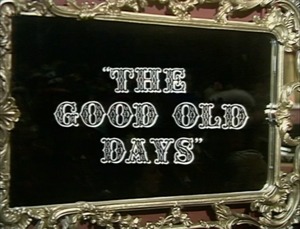
The Good Old Days was a strange show. It ran for a staggering thirty series, from 1953 to 1983. The format recalled the days of Victorian/Edwardian variety theatre. Contemporary entertainers performed material in the style of that era. Everyone - from the verbose compere Leonard Sachs, to the stars and the audience - would dress in clothes of the period. What makes the show's extended lifespan even more remarkable is the fact that it bored the life out of anyone below the age of forty.
All the top UK acts and some from further afield graced that dusty old stage, but very, very few commanded it with such presence and style as Eartha Kitt did in 1972.
youtube
4 notes
·
View notes
Text
Somewhere Between Heaven and Hell, There Was Harry Hill's
From the Lambs’ Joe Laurie Jr Collection
Harry Hill (1827-1896) died of an August 27. The exact date of birth is not known; he was not of the class that kept careful track of such things. Hill was born in the vicinity of Epsom Downs in England. His uncle was a gambler there and Harry grew up in and around the racetrack. Disreputable? Perhaps. But on the other hand, he learned how to take care of…
1 note
·
View note
Text

Happy Second Quangle to all who celebrate 🧀
#a quangle... IN TIIIIIMMMEEEE#the time knife#yeah yeah the cheddar variety#dimension 20#time quangle#betrayed by live theatre#d20 spoilers#spoilers#hell yes Sir Annabelle Cheddar#Arthur Aguefort#Gilear Faeth#the evil cheesemonger#aka#rumplestiltskin#time quangle spoilers
75 notes
·
View notes
Text
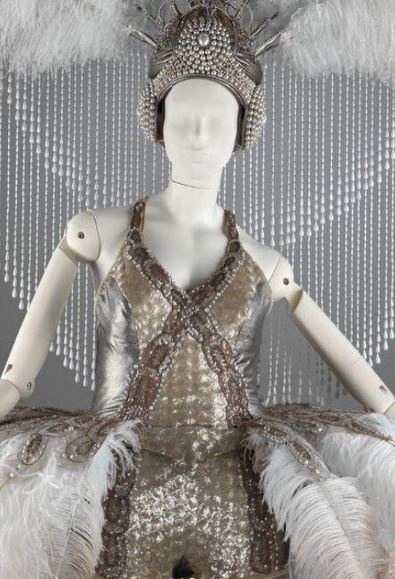
𝚃𝚑𝚒𝚜 1920𝚜 𝚜𝚑𝚘𝚠 𝚐𝚒𝚛𝚕 𝚌𝚘𝚜𝚝𝚞𝚖𝚎 𝚠𝚊𝚜 𝚠𝚘𝚛𝚗 𝚋𝚢 𝚈𝚘𝚞𝚗𝚐 𝚂𝚘𝚕𝚊𝚗𝚐𝚎 𝚒𝚗 𝚝𝚑𝚎 𝚖𝚞𝚜𝚒𝚌𝚊𝚕 𝚛𝚎𝚟𝚒𝚟𝚊𝚕 𝚘𝚏 𝚃𝚑𝚎 𝙵𝚘𝚕𝚕𝚒𝚎𝚜 𝚊𝚝 𝚝𝚑𝚎 𝙽𝚊𝚝𝚒𝚘𝚗𝚊𝚕 𝚃𝚑𝚎𝚊𝚝𝚛𝚎. 𝚃𝚑𝚎 𝚌𝚘𝚜𝚝𝚞𝚖𝚎𝚜 𝚠𝚎𝚛𝚎 𝚍𝚎𝚜𝚒𝚐𝚗𝚎𝚍 𝚋𝚢 𝚅𝚒𝚌𝚔𝚢 𝙼𝚘𝚛𝚝𝚒𝚖𝚎𝚛.
#fashion #fashiongram #fashionable #fashionphotography #fashionlover #fashionart #fashionaddict #fashionphotographer #fashionpost #fashionshoot #fashionlove #fashionlovers #fashioneditoral #editoral
𝚂𝚘𝚞𝚗𝚍𝚝𝚛𝚊𝚌𝚔: 𝚃𝚛𝚊𝚒𝚗 𝚋𝚢 𝙶𝚘𝚕𝚍𝚏𝚛𝚊𝚙𝚙
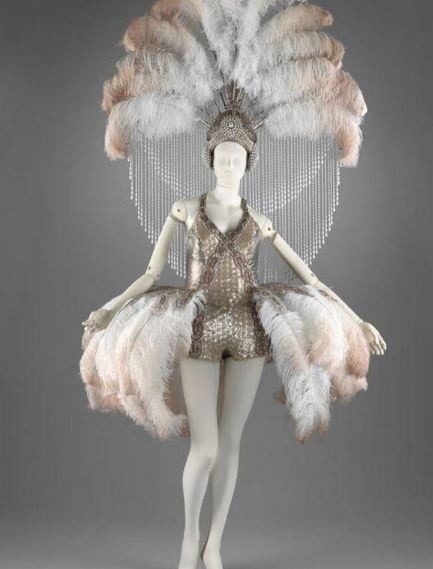
#l o v e#sexy costumes#costumes#national theatre#5/2024#The Follies#musicals#Young Solange#costume#1920s fashion#1920s cinema#1920s#Vicky Mortimer#fashionlovers#fashion love#fashion photographer#fashionaddict#fashion art#nostalgia#aesthetic#fancy#x-heesy#music and art#contemporaryart#vintage#vintage fashion#fashion history#show girl costume#show girl#variety
24 notes
·
View notes
Text







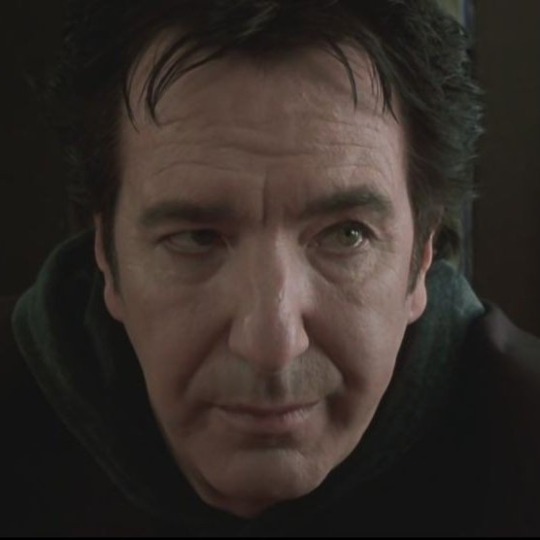


44 notes
·
View notes
Text
people on twitter calling jeremy jordan overrated????
#i’m genuinely confused like??#he’s got an insane vocal range#a fantastic actor#great at adding character to his voices for different characters??#but this does happen when an actor is very popular#but it surprised me because of his variety in performances#broadway musicals#jeremy jordan#musical theatre
14 notes
·
View notes
Text
oswlld's monthly wrap up: april
note: i am trying something a bit different this year, so bear with me as i figure out how i want to format this. i wanted to spend more time sharing what i consume, beyond what i rb, and put my thoughts in one place. these posts are okay to rb
--
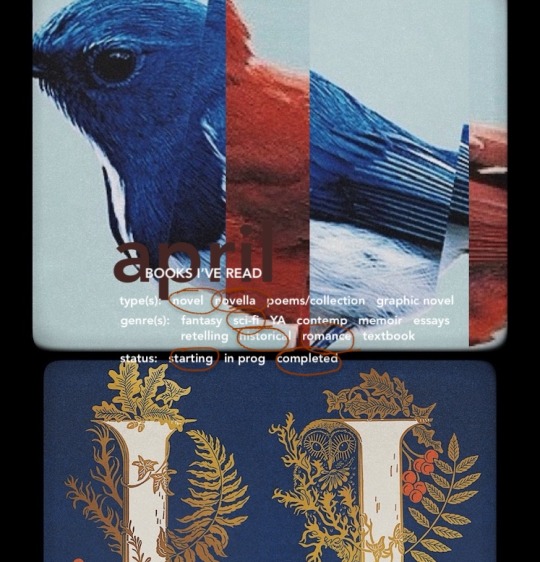
This Is How You Lose the Time War, Amal El-Mohtar & Max Gladstone [started 04/04, finished 04/09] *drags my hands down my face until the end of time* I want to meet you in every place I ever loved. I want to meet you in every place I ever loved. I want to meet you in every place I ever loved. I want to meet you in every place I ever loved. I want to meet you in every place I ever loved. I WANT TO MEET YOU!!!! IN EVERY PLACE I EVER LOVED!!!!!!!!!!!!! 4.75⭐️ in storygraph. — Hamnet, Maggie O’Farrell [started 04/12, in prog] I am about 100 pages in and still not sure if I want to keep going or DNF it. idk what isn’t sticking because the writing is beautiful and the pacing is great. And I do care about the characters, I really do. I love the way the author borrows from future grief, it’s what I am enjoying most about this read so far. Maybe I’ll give it 50 more pages and see if it finally sticks.
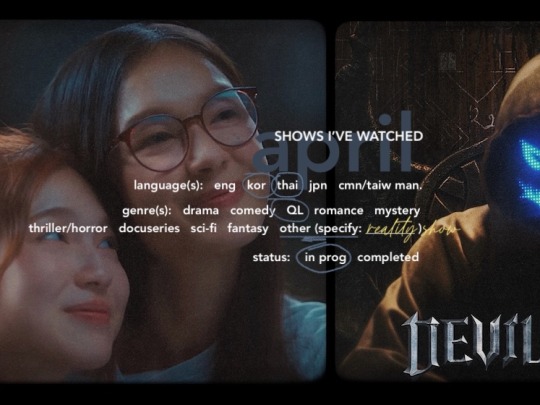
23.5 Degrees, GMMTV [started: 03/08, ongoing] As mentioned, I am caught up on eps 3-8. I’ll likely not be able to watch it live in may but I will be keeping up with the series til the end. It’s so lighthearted and charming! Not sure how they managed this, but I am constantly surprised by the character group dynamics. It’s def due to the great chemistry everyone has with literally everyone. I need NEED to discuss the score of this show because it’s IMMACULATE. The celestial themes, from the props all the way down to the music, is so rich. I’m so excited to see how this story unravels. — Devil’s Plan [started: 04/23, ongoing] This is a bestie pick, a show my best friend chose to have us watch on our facetime calls. We are 1.5 eps in and it’s a grower. The first game is hella complex and we’re slowly picking up on what’s happening. The people on this show are incredibly intelligent, so I feel like I have to work extra hard to keep up. It does feel rewarding, I’m hooked.

Oppenheimer, Peacock [watched on 04/05] I am a self-proclaimed Nolan girlie, I’ll admit it. I do enjoy his work and the many ways he translates time into film. When I wrote this, it had been a few days since I watched it and I still think abt the little moments that blew me away. Moments like the accentuated dust particles, how the coloring of the movie can be an unreliable narrator, and the utilization of a crowded hall stomping their feet to create tension. The last eight minutes still haunts me. I find more value in the technical side of film, but I will give credit when credit is due: every award Cillian Murphy got this season was so well earned. He carried all three hours of that film with such powerful quietude. And lastly, my heart now belongs to Jennifer Lame. Upon seeing her accept the award for Best Film Editing for Oppenheimer, I have come to learn that she also edited Tenet. HER MIND!!! She has such a bright future ahead of her, to be up there with the minds of Thelma Schoonmaker and Anne V Coates. — Yellow Door: ’90s Lo-Fi Film Club [watched on 04/14] This film needs to be studied in film school. It’s incredibly meta in some ways, having renown directors be the subjects, talking about their passion for film. The production being so stylized and the editing feels very reminiscent of Our Beloved Summer, with the way the found footage and the aspect ratios are intertwined with current day quality shots. This film will hit everyone right in the millennial. A true surprise for me is discovering that Bong Joon Ho and I are more alike that I had originally thought. The way he speaks in casual conversation and his story of setting strict rules for their film collection had me hollering because SAME. The most jessi thing he recounted was how all the VHS tapes were labelled. Yellow Door is somehow the opposite of the "doesn’t take itself too seriously" mentality; it’s actually so great that they made the film like that. By fully immersing us with gorgeous cinematography, cheeky editing sequences, and lush music to tug at your heartstrings, it bewitches you into loving film as much as they did. And still do.
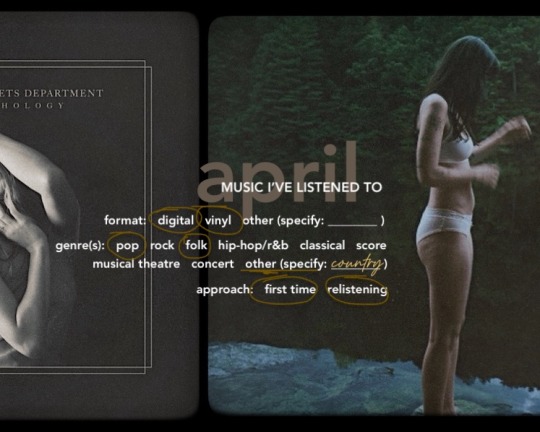

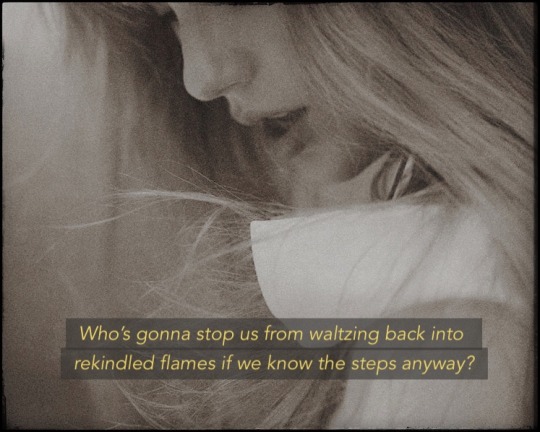
Cowboy Carter, Beyoncé [relisten] I’ve given this several good cycles to confirm my first impressions: it’s def one of her most cohesive albums to date and still stands as a spectacular album. This passion project of hers takes such great care and attention to the voices she amplifies. I can feel the hunger, the innate need for her to make this album. If you haven’t heard how this album came to be, I insist you take the time to educate yourselves. It makes the listening experience so much more empowering. Good for her… GOOD. FOR. HER!! Current favs: Ameriican Requiem, 16 Carriages, Bodyguard, Jolene, Spaghettii, Ya Ya, Desert Eagle, II Hands II Heaven, and Sweet/Honey/Buckin’. — Older, Lizzy McAlpine [first time listening] Coming off the heels of my Five Seconds Flat hyperfixation last year, I haphazardly went into Older hoping its a natural progression in production value. I was shocked that it turned out to be a completely different sound. I soon learned that she actually didn’t really like how Five Seconds Flat was produced because it didn’t feel true to her as an artist. Tbh I was feeling a little lost after the first listen but after digesting this new info, I went back into it and appreciated it a lot more. In fact, the third listen was when I realized that it gave off the same energy as Laufey. I’m excited to listen to it again soon. — Stick Season: Forever, Noah Kahan [first time listening] Having stumbled on all the collabs on Alexa earlier this year, Forever was the only new song for me from his latest release. I’m OBSESSED with this song!!!! The way his voice carries the entire weight of every hurt inside me and just takes it away. Something healed in me. I play it in the car every time I leave the house. I cry in the car every time I leave the house. — The Tortured Poets Department, Taylor Swift [first time listening, standard vinyl ed.] I am going to get this out of the way and say that this album is great. Just great. I understand more than ever why she felt the need to make this album. Having only listened to the standard version a couple times and the anthology twice through, I sit here in this kind of… discomfort. And I’m kind of okay with that feeling. But… it pains me that I can’t share this album with some people in my life and it’s largely due to how she depicts her struggles with people with mental illness/addiction. It’s one, if not the biggest, strike I have against this album and by extension, her. Songs cycling in my head: Down Bad, So Long London, Guilty as Sin?, Who’s Afraid of Little Old Me?, loml, imgonnagetyouback, Chloe or Sam or Sophia or Marcus, How Did It End?, I Look in People’s Windows, The Prophecy, Peter, and The Manuscript.
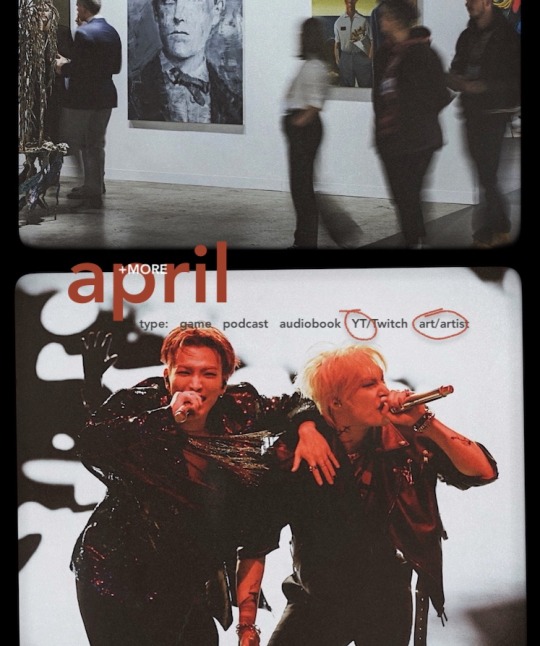
EXPO Chicago [attended 04/13] Yes, I am doxxing myself a bit if you didn’t already know. During college, I used to attend EXPO yearly and occasionally went back long after I finished school. I haven’t attended in a long time, so I made it my goal to attend this year. And I had a blast! My mother tagged along and she’s not one to attend shows like this or art museums in general. It was a beautiful day trip to the city and it was nice to have her company. She mostly trailed behind and took pics of me as I floated around the exhibition hall. I have 50+ artists I tracked on my phone to actively research in my spare time. I sat in on one of the panel talks (ON COLOR), discussing color theory in today’s bipoc landscape. I took so much away from that conversation, it was very charged. I'm kinda obsessed with Alteronce Gumby, I need to do an artist deepdive on his work. — Coachella [watched from 04/12 to 04/14] I work for a big tech company and one of the biggest events to be on standby for is Coachella. I had to be on call for Friday and was backup support for Sunday lineups. Thus, Saturday was the only day I could sit back and relax while watching. My first time lineups included: Hatsune Miku, Peso Pluma, Late Night Drive Home, Jon Batiste, Ateez, le Sserafim, Purple Disco Machine, Bleachers, No Doubt, 88rising Futures, and Latin Mafia. Of all of the performances, I want to take a full deep dive into Ateez and Peso Pluma’s discography in the near future.
#oswlld 2024 wrap up#mine: edits#long post#this is how you lose the time war#23.5 degrees#devil's plan#oppenheimer#bong joon ho#yellow door#cowboy carter#beyonce#lizzy mcalpine#noah kahan#taylor swift#alteronce gumby#ateez#peso pluma#ive been tackling ttpd as though it was folklore/evermore#it reads more like sister albums for me it gives length and structure like musical theatre cast recordings#i dissect the narrative in acts#and im enjoying the writing and narrative more in ttpd standard#but i LOVE the production and variety of topics in the anthology collection#this level of vulnerability and info dumping is not for everyone#and tbh it might not even be for me but it doesn’t make it a bad album#it’s like… i get why there’s criticism about how it needs to be edited down or polished or that it needed ‘more time’#i do get it and a part of me buys into it#imo she’s prob too big to fail. she can get away with almost anything at this rate#im still enjoying it tho. she's a grower#i have the rest of time to have it grow on me. there will be songs that will hit harder in a week/month/year#sorry about the tangent see yall in june
13 notes
·
View notes
Text
Grand Arena [Variations] by Balatro






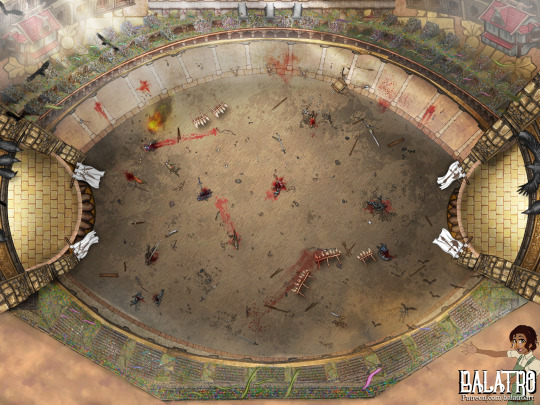
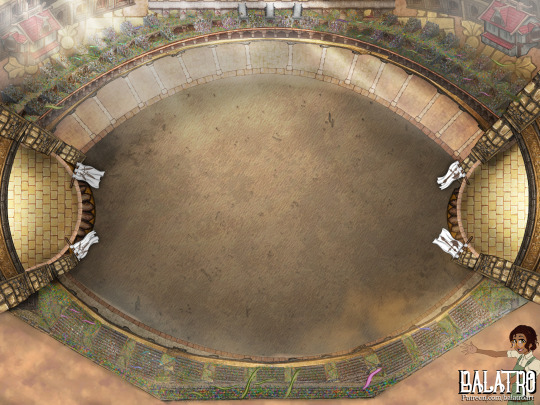

60 notes
·
View notes
Text
sitting my loved ones down and forcing them to watch behind the scenes videos of theatrical puppets with me.
#cricket.chatterbox#you WILL marvel at the many different ways you can achieve the same visual effect#with a variety of different designs you WILL compare the pros and cons of the sven broadway puppet approach#to the national theatre war horse joey puppet approach you WILL do a guided reflection afterward there WILL be discussion questions
8 notes
·
View notes
Text


𝕴f you grew up reading 𝙂𝙤𝙤𝙨𝙚𝙗𝙪𝙢𝙥𝙨 or watching the 𝙘𝙪𝙡𝙩 𝙘𝙡𝙖𝙨𝙨𝙞𝙘𝙨 you’re gonna have to check out our 𝑽𝒂𝒓𝒊𝒆𝒕𝒚 𝑺𝒉𝒐𝒘 𝒐𝒇 𝑯𝒐𝒓𝒓𝒐𝒓𝒔! 𝕺ur next episode, taking place 𝙩𝙝𝙚 𝙛𝙞𝙧𝙨𝙩 𝙬𝙚𝙚𝙠𝙚𝙣𝙙 𝙤𝙛 𝙎𝙚𝙥𝙩𝙚𝙢𝙗𝙚𝙧, is titled 𝖉𝖔𝖚𝖇𝖑𝖊 𝖋𝖊𝖆𝖙𝖚𝖗𝖊 & followsᆞ2ᆞoriginal 𝙗𝙡𝙤𝙤𝙙 𝙘𝙪𝙧𝙙𝙡𝙞𝙣𝙜 stories set in the humble town of 𝘾𝙧𝙖𝙬𝙛𝙤𝙧𝙙𝙫𝙞𝙡𝙡𝙚 during the 1980’ꜱ
• 𝙜𝙪𝙖𝙧𝙖𝙣𝙩𝙚𝙚𝙙 𝙩𝙤 𝙠𝙚𝙚𝙥 𝙮𝙤𝙪 𝙤𝙣 𝙩𝙝𝙚 𝙚𝙙𝙜𝙚 𝙤𝙛 𝙮𝙤𝙪𝙧 𝙨𝙚𝙖𝙩 •
& 𝕹𝖔𝖜, 𝔴𝔢 𝔭𝔯𝔢𝔰𝔢𝔫𝔱 𝔱𝔬 𝔶𝔬𝔲 . . .
#springfield#missouri#theater#aesthetic#dark#theatre#acting#play#live#live action#horror#necrobroth#art#edgy#spooky season#september#variety#show#scary#story#goosebumps#cult#classic#cult classic#nuclear#family#grunge#murder#mystery#cabin in the woods
2 notes
·
View notes
Text
Decided to binge watch the entirety of Pokémon Generations again because it's been a few years since I last saw it and uh
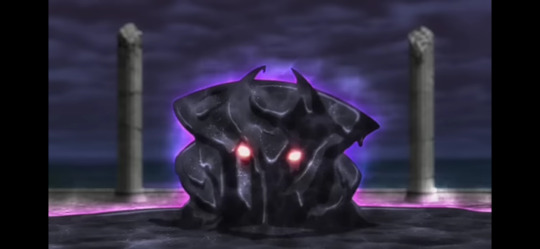





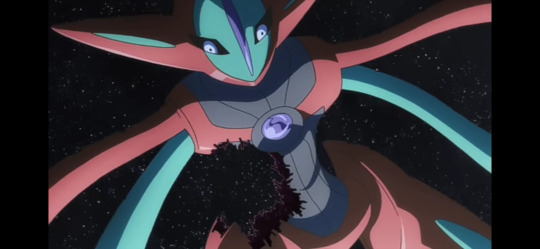

Is it just me or is it a lot more fucked up than I remember
#Pokémon#Pokémon Generations#I GENUINELY CAN'T FUCKING BELIEVE THAT SOME OF THESE ARE ACTUAL HONEST TO GOD SCREENSHOTS FROM OFFICIAL POKÉMON CONTENT#Featuring fun family friendly scenes of cute doggies burning to death!#A nuked ancient civilization!#A scene of frozen corpses right out of The Day After Tomorrow and Geostorm but drawn in Pokémon art style!#Team Aqua getting felled by hubris and devoured by Primal Kyogre!#Whatever the fuck Courtney has got going on!#I would have included Groudon blowing up Hoenn and incinerating Team Magma but I wanted to include only one screenshot from that episode#For variety#Also that scene of Mimi the Espurr getting punted like a football. :(#It's like the animators thought Hey This Is Only For YouTube and Only Older Kids are On YouTube Anyway So We Can Be Edgy :)#I saw Pokémon The Power Of Us in cinemas and they showed the Legendary Beasts backstory episode as a short before the movie#Only problem the audience was filled with the elderly and parents taking their kids to see Funny Cute Pokémon Movie#So I was pretty much the only one who had context for WTF we just witnessed#Actually that short caused one family to get up and leave :)#Imagine not knowing anything about Pokémon and taking your four year old to see Funny Cute Pokémon Movie#Only to have to take your crying kids out of the theatre cause they got traumatised by watching animated dogs burn alive#All before the movie even started#Core childhood trauma memory formed right there#Actually now that I remembered the old lady in The Power of Us had a traumatic backstory of witnessing her Snubbull burn to death in a fire#Number of animated dogs dying in a fire in this one cinema trip: 4#Like what the actual fuck
12 notes
·
View notes
Photo



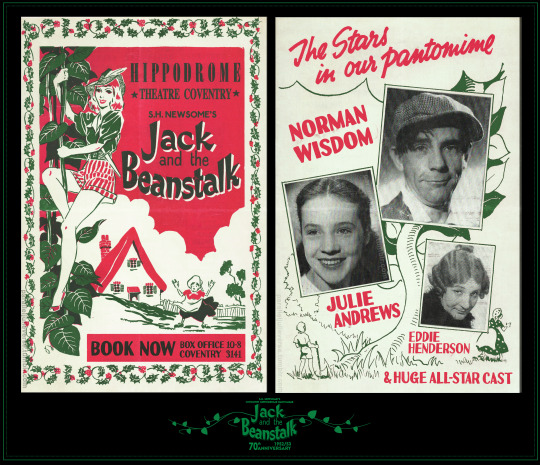
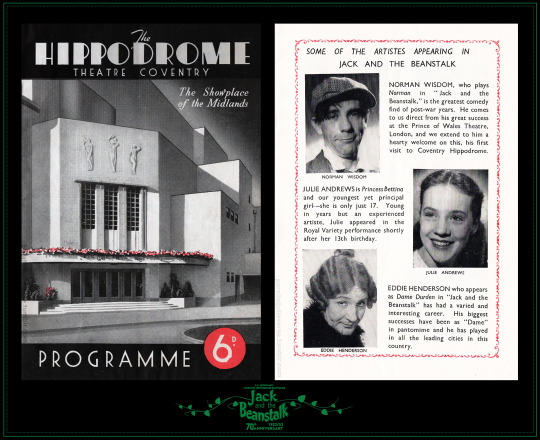



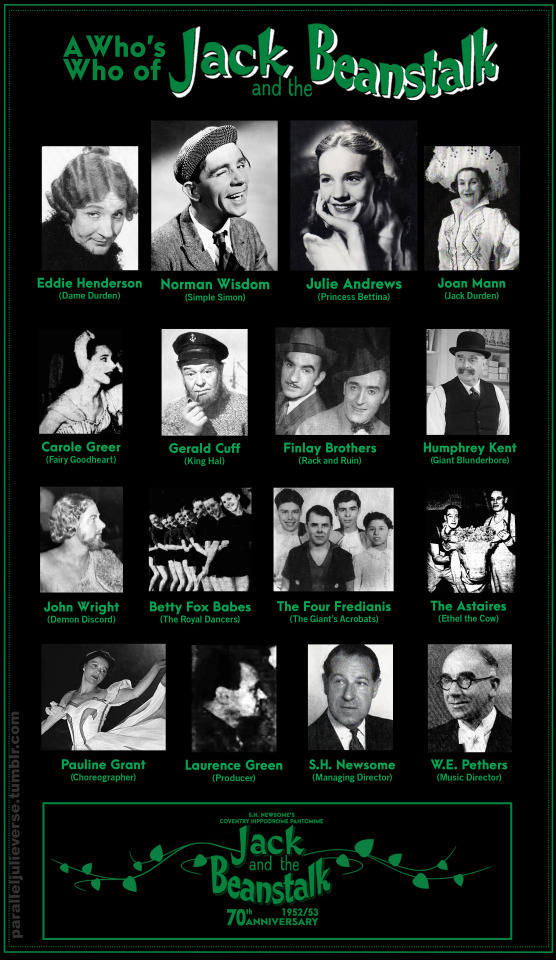
70th anniversary of Jack and the Beanstalk
Coventry Hippodrome, 164 performances
(23 December 1952 - 28 March 1953)
This week marks the 70th anniversary of a milestone event in the juvenile career of Julie Andrews: the opening of Jack and the Beanstalk at the Coventry Hippodrome on 23 December 1952. It would be Julie’s fourth annual pantomime, following Humpty Dumpty (1948), Red Riding Hood (1950) and Aladdin (1951).
That Jack and the Beanstalk was a provincial production -- rather than a West End show -- could be misconstrued as a career comedown for the young star. After all, twelve months earlier she was principal girl in Aladdin at the London Casino and the following year she would headline the 1953 production of Cinderella at the London Palladium. But an appearance at the Coventry Hippodrome was no small affair.
The Showplace of the Midlands
Dubbed “The Showplace of the Midlands”, the Hippodrome was an ultra-modern Art Deco entertainment palace lovingly built and managed by automobile industry baron cum entertainment impresario, Sam Newsome. With a massive 2000-seat auditorium, multi-levelled foyers and bars, twelve dressing rooms and its own broadcasting studio, the Hippodrome occupied over one and a quarter acres in the heart of Coventry. It was the biggest and most up-to-date theatre in the country -- and it quickly established itself as the foremost Midlands venue for touring dates, attracting a stream of headline acts and hosting regular seasons from major companies including The D'Oyly Carte Opera and Sadler’s Wells Opera (Newman 1995).
The Coventry Hippodrome was especially celebrated for its spectacular Christmas pantomimes. Newsome took “personal pride and delight in his pantomimes” and ensured they “possessed a thoroughly exclusive quality” that distinguished them from run-of-the-mill seasonal fare (Stephens 1965, 6). Planning for each year’s panto would start months in advance with generous budgets, top-notch creative talent, high production values, and big star names.
It was a calculated business strategy on Newsome’s part. Not only would each Christmas panto be an assured money-earner for his theatre, but, once it had debuted in Coventry, it would subsequently be re-mounted -- using the same scripts, sets, costumes and, sometimes, cast members -- in other theatres. It was not uncommon for a different Newsome pantomime to be playing simultaneously in five or six theatres around the country (Auty, 20; Newman, 77). In the case of Jack and the Beanstalk, for example, Newsome would re-stage the show repeatedly over ensuing years including runs at the Dudley Hippodrome in 1953/54; the Derby Hippodrome in 55/56; the Swansea Empire in 56/57; the Brighton Hippodrome in 57/58 and the Bradford Alhambra in 59/60 (The Stage).
Launching Jack and the Beanstalk
In early 1952, Newsome announced that his next Christmas pantomime at the Coventry Hippodrome would be an “entirely new and magnificent production” of Jack and the Beanstalk, a popular source for pantos since the early-19th century and a sure-fire crowd pleaser. A “firm believer in maintaining the well-loved traditional features of Pantomime”, Newsome’s production of Jack adhered faithfully to the plot of the well-known fairy tale about the adventurous village lad turned Giantslayer, but with lashings of pantomime essentials of music, spectacle, comedy and dance. (Newsome: 1).
Overseeing the production and taking on directorial duties was Laurence Green, something of a right-hand man for Newsome throughout this era. The book was developed by the celebrated lyricist team, Barbara Gordon and Basil Thomas, who were also Newsome panto regulars. Other key members of the production team included costume designer, Michael Bronze, and set designers, Josef Carl and Tod Kingman, who created a series of impressive backdrops and props including a giant hand that in one scene whisked Julie aloft into the theatre fly tower (Foxon: 6; Whetsone: 3).
In terms of music and dance, there were seventeen full musical numbers with a mix of classics, pop standards, and bespoke compositions, all arranged and orchestrated by the Hippodrome’s longtime music director, W.E. Pethers. Celebrated choreographer, Pauline Grant was commissioned to develop several dance routines including an Act 1 closing ballet sequence and a grand finale parade.*
As always, one of the most important elements in the show was its roster of on-stage talent. And for Jack and the Beanstalk, Newsome assembled a star-studded line-up from the fields of theatre, variety, film, and dance. To optimise marketing potential, the principal cast was announced in June, a full six months before the show was set to open. Julie was cast in the principal girl role of Princess Bettina, alongside Joan Mann as Jack; Eddie Henderson as Dame Durden; and, the undoubted comic star of the show, Norman Wisdom as Simple Simon (‘Norman Wisdom to star’: 6).
Stories and profiles about the stars were fed in regular instalments to the local and regional press, ensuring continued exposure and boosting public anticipation (’Pantomime Star’: 4; ‘Julie is so determined’: 6). Julie even made a ‘surprise’ PR visit to Coventry in the first week of November to join the theatre’s special Birthday Show (‘Behind the footlights’: 9). The star-driven marketing paid off handsomely with brisk ticket sales. By early-December, a quarter of a millions seats had been booked -- a theatre record -- and the run was extended from 12 to 14 weeks (’Quarter of a million...”: 4).
The Singing Princess
Though she would be second fiddle to the show’s top billed player, Norman Wisdom, Julie was an important drawcard for Jack and the Beanstalk. Much was made of her youth and the fact that, at just seventeen, she was the youngest principal girl ever to appear in a Newsome pantomime (’Pantomime Star’: 4; ‘Julie is so determined’: 6).
And, as John Cottrell (1968) notes, “[f]or the first time in her life she was treated like a star” (62). She was given one of the theatre’s best dressing rooms with its own private bathroom -- and Newsome made sure that it was decked out with fresh flowers each week, even during rehearsals (Andrews: 146; Cottrell: 61).
Julie also commanded a star-like fee, securing a contract for a whopping £250 per week, reported to be an era record for a pantomime principal girl (Cottrell: 61). It was a burst of newfound wealth that allowed the young star to buy her first car -- which she dubbed ‘Bettina” in honour of the character she played in the show -- and assume control from her parents of the mortgage on ‘The Old Meuse’, the family home in Walton (Andrews: 147).
As Princess Bettina, the object of Jack’s affection who is rescued by the young hero and united with him in the mandatory happily-ever-after finale, Julie had one of her biggest stage roles to date. Combining moments of royal pageantry, abduction and imprisonment, thrilling rescue, and budding romance, the script afforded an opportunity for the young actress to flex her growing dramatic talents.
Needless to say, Jack and the Beanstalk also showcased Julie’s most famous asset: her voice. She was given six full musical numbers in the show -- four solos and two duets -- comprised of:
‘If You Feel Like Singing’: This popular Warren-Gordon song had only recently been introduced in the 1950 MGM film, Summer Stock, where it was performed by Judy Garland (Larkin 1992). In the show, Julie sings the number in Scene 1 as her character is wandering alone in the forest and is spied by Jack who instantly falls in love wth her. With its lyrical ode to expressive singing and repetitive tra-la-las, the song would have provided a perfect showcase for Julie’s brand of light coloratura trilling.
‘Am I in Love’: Another newly-minted Hollywood number, this Oscar-nominated song by Jack Brooks was first performed by Bob Hope and Jane Russell in the 1952 Paramount release, Son of Paleface (Benjamin and Rosenblatt 1993). In the show, Julie sings it in Act 1 as a duet with Jack (Joan Mann) and reprises it again a few scenes later as a solo.
‘You Made Me Love You’: This well-known pop standard by Monaco and McCarthy was first performed by Al Jolson in 1913. It quickly became an international hit and part of the Great American Songbook, covered by a wide variety of famous vocalists including Jeanette MacDonald, Bing Crosby, Doris Day and, in a slightly revised version, Judy Garland in The Broadway Melody of 1938 (Whitburn 1986). In the show, Julie sings it in Act 1 as a duet with Norman Wisdom in the comic star role of Jack’s bumbling younger brother.
‘Yesterdays’: This classic ode to lost loves from the 1933 Kern and Harbach musical Roberta has been performed by many singers over the years including Irene Dunne, Mario Lanza, Barbra Streisand and Kiri Te Kanawa (Larkin 1992). One can only imagine how lovely Julie’s version would have been, sung as the imprisoned Princess pines for her home at the start of Act 2.
‘The Belle of the Ball’: Written in traditional Viennese style, this bouncy LeRoy Anderson waltz was introduced in 1951 and quickly became a light classical standard that has been played over the years by countless pop orchestras and school bands. It also has a lesser known sung version with lyrics by Mitchell Parish (Whorf 2012). It is that version that Julie performed in the show as her final solo. Hippodrome music director W.E. Pethers clearly liked LeRoy Anderson because Jack and the Beanstalk featured another of the composer’s orchestral works, ‘The Syncopated Clock’, used for the opening dance in Act 2.
‘You Belong to Me’: This romantic ballad was another newly-minted hit in 1952. First recorded by Joni James, it was made famous by Jo Stafford in a chart-topping single that became an international sensation. With its lilting melody and evocative opening lyric -- “See the pyramids along the Nile...” -- it became one the era’s most popular love songs and was recorded by many of the biggest vocalists of the 1950s such as Ella Fitzgerald, Patti Page, Dean Martin and, in the UK, Alma Cogan (Larkin 1992). The song was used in Jack and the Beanstalk as the final love duet between Jack and Princess Bettina.
A Who’s Who of Jack and the Beanstalk
Alongside our Julie, other key talents involved in the cast of Jack and the Beanstalk included:
Norman Wisdom as Simple Simon: The beloved 'sentimental clown’ of British theatre, film and television, Wisdom shot to meteoric fame in the late-40s and early-50s with an appealing brand of character-based physical comedy. Sporting a trademark crumpled suit and upturned tweed flatcap, he crafted an endearing persona nicknamed "The Gump," a well-meaning, bumbling Everyman who failed at everything but won hearts in the process. A talented musician and vocalist, Wisdom included songs as a central part of his act which he would use to great effect in accentuating the warm-hearted pathos of his comedy (Bullar and Evans: 186).
As with many stage performers of the era, Wisdom made frequent forays into pantomime, starting with a well-received debut in Robinson Crusoe at the Alexandra Theatre Birmingham in in 1948/49. By the time of Jack and the Beanstalk, Wisdom was a major star and the show gave him free rein in several set pieces including five songs, three of which he wrote himself. In his memoirs, Wisdom (2002) fondly recalled his time in the show, making special mention of Julie who, he writes, “had a freshness about her that was totally captivating” (181).
Following Jack, Wisdom went on to an even bigger career in film with a string of hit comedies for Rank that saw him become one of the most popular stars of British cinema of the 50s and early-60s. Though his style of sentimental slapstick would fall out of fashion, Wisdom remained a much-loved national icon. In recognition of his contributions to British cultural life, he was knighted by the Queen in 2000. He passed away in 2010 at the grand age of 95 (’Sir Norman Wisdom’: 29).
Eddie Henderson as Dame Durden: Though he is little remembered today, Scots-born Henderson was a popular figure of mid-century British theatre and variety. A self-taught dancer and comic actor, Henderson had a diverse career that stretched across music hall, cabaret and ‘legitimate theatre’. In the inter-war years, he toured widely in revues and productions around the UK and abroad. He played opposite a young Ronald Colman and even co-wrote a play with Reginald Furdell (Ashley: 2). Henderson was especially renowned as an accomplished panto Dame. He played a long line of comic Dames from the 1930s into the early-60s, earning him the soubriquet “Queen of Dames” (Durbridge: 5). Jack and the Beanstalk would be the first of several pantomimes that Henderson would do for Newsome during the 1950s, before retiring in the early-60s.
Joan Mann as Jack: Welsh-born Mann trained as a dancer and started touring the variety circuit in her teens where she appeared on bills with stars including Max Miller and Tommy Trinder. A tall attractive brunette with a pleasant voice and shapely dancer’s legs, Mann was a perfect pantomime boy. She played in top pantos in Glasgow, Edinburgh, and Liverpool, before making her Coventry debut in Jack and the Beanstalk. Julie relates in her memoirs that she and Mann roomed together during the run of Jack and, despite a 15-year age difference, they became firm friends. Mann would re-team with Julie in 1953 as part of the musical revue, ‘Cap and Belles’ (Andrews: 146).
Mann’s greatest fame came as part of the celebrated Fols-de-Rols variety troupe with whom she performed for almost two decades. She also starred opposite Dame Anna Neagle in the hit West End musical, Charlie Girl in the late-1960s. Mann died in 2007 aged 87 (P.N.: 53).
Finlay Brothers as Rack and Ruin (The Broker’s Men): One of the many novelty acts popular in mid-century variety, the Finlay Brothers started as a comic musical trio in the late-30s. Billed as “the English replies to the American Marx Brothers”, they blended song, dance, slapstick, sketch comedy and vocal impressions into a fast-paced routine (’What’s On’: 10). When one of the brothers called it quits following the war, Jack and Herbie Finlay continued as a duo, using a classic straight man/clown pairing. One brother would try to sing and act dramatically but the other would forever interrupt with ludicrous gestures and facial expressions, setting the scene for a manic spectacle of physical comedy. It played well in the era and, come Christmastime, the Finlay Brothers would be in demand as comic supports for panto. In Jack and the Beanstalk, they played the comic duo part of the Chancellor’s bumbling officials with much opportunity for audience-pleasing slapstick. The Finlay Brothers continued variety touring and Christmas pantos into the late-50s before retiring (’Pantos last’: 4).
The Four Fredianis as the Giant’s Acrobats: Part of a multigenerational lineage of Italian circus performers dating back to the 17th century, the Four Fredianis was a family group of acrobats comprised of father, Giovanni, and his three sons, Rolando, Guglielmo, and Bruno (Cochran: 38). Giovanni had grown up performing in his own father’s circus troupe in Europe before branching out on his own. He settled in the UK where the Four Fredianis moved from circus work into the more stable and lucrative field of variety and theatre. In fact, the Fredianis shared an earlier variety bill with Julie as part of the Look In revue which toured through the spring of 1952 (‘At the Theatre: 4). In Jack and the Beanstalk, they were cast as ‘The Giant’s Acrobats’ encountered by Jack on his way to the Giant’s castle, but their role was essentially to bring increased spectacle and physical excitement to the show’s proceedings.
Gerald Cuff as King Hal: Playing the part of Princess Bettina’s ‘merry monarch’ father, Gerald Cuff started his career in repertory where he performed for many years as part of the celebrated Derek Salberg Company in Wolverhampton (’Personality’: 13). During out-of-season spells he would appear frequently in pantos, many of them for Sam Newsome. In fact, he would reprise his role as King Hal in the Dudley Hippodrome season of Jack and the Beanstalk the following year (B.M.: 6). Cuff’s lasting claim to fame came in 1958 when he was cast as ‘The Bosun’ in the popular British TV series of Popeye (Ashley, R.: 20). In his spare time, Cuff was a publican in his hometown of Wolverhampton. He died in 1963 at the sadly young age of 58 (’Obituary’: 7).
Carole Greer as Fairy Goodheart: Trained as a ballet dancer from childhood, Scottish-born Greer started her theatrical career at age 16 when she first appeared in pantomime during school holidays. She then toured the variety circuit for a few years as part of a dance duo with Barrie Manning. Greer was subsequently championed by choreographer, Pauline Grant, who cast her as principal dancer is several shows, including Jack and the Beanstalk (Thespis: 9). She appeared for two seasons with the Gyndebourne Opera Company, including a tour of Germany (’Flying opera’: 5). She also performed in a few London shows, notably Fun and the Fair at the Palladium in 1953. Like others in the cast, Greer would reprise her role as Fairy Goodheart in the Dudley Hippodrome season of Jack and the Beanstalk the following year (B.M.: 6). Thereafter, the public trail for Greer grows cold. Like many women of that era, she may have married and changed her name and/or possibly retired from the stage.
Humphrey Kent as Giant Blunderbore: Born in Hertfordshire, Kent was a regular in regional theatre throughout the 40s and 50s. He had an early success as part of the cast of the touring production of Lesley Storm’s Great Day in the mid-40s. Thereafter he seemed to settle in to a steady stream of local productions with the occasional brief appearance in film and TV. He did some film voicework including working with Julie on the British dubbed version of the Italian animated feature, The Rose of Barghdad (1952) where he voiced the part of Tonko (’Rose’:43). A tall, well-built man with a booming voice, Humphrey was ideal for the part of the Giant, a role he would reprise several times over the years (’Panto Giant’: 9).
John C. Wright as Demon Discord: Born in Northampton, Wright studied at the Repertory Theatre where he appeared opposite Sonia Dresdel and Freda Jackson. A classically trained tenor, he performed widely in opera and musicals in the interwar years, including several seasons with the Carl Rosa and Sadler's Wells Opera Companies. After the war, Wright went on to become manager of the Sadler’s Wells Opera but continued to perform periodically in various theatre productions. He did some early TV work including an appearance in the the landmark serial, Quartermass Experiment (Foxon: 6). In Jack and the Beanstalk, he played the Giant’s malevolent henchman, the Demon Discord, a role he would recreate the following year at the Dudley Hippodrome (B.M.: 6). Wright died in 1963 at the age of 64 (’John Wright’: 21).
The Astaires as Ethel the Cow: No pantomime would be complete without a ‘skin’ role and in the case of Jack and the Beanstalk that is Dame Durden’s long-suffering cow. Variously named Daisy, Buttercup, Daffodil, Mabel or, as here, Ethel, the cow is an important part of the story and a source of competing comedy and pathos for the audience. Pulling it off while cloaked in a heavy costume and operating multiple parts is no mean feat. In the case of this production, the job fell to Jimmy and Ernie Astaire, two brothers from a family of entertainment troupers. Their father, George Astaire founded a stilt-walking puppet troupe, the Seven Gullivers, that toured the country and was especially popular as a novelty act in pantomime. After their father died, the sons continued the troupe while also branching out with their own novelty duo act whose showpiece would see them tap dance on stilts up and down a staircase. They even performed the act as part of the 1947 Royal Command Variety Show. The Astaires did double duties in Jack and The Beanstalk, playing both Ethel the Cow and also leading the Seven Gullivers troupe who played the part of the Giant’s Henchmen (’It’s Hard Work’: 5).
The Betty Fox Babes: One of many companies of dancing juveniles popular in the era, the Betty Fox Babes were products of the Betty Fox Stage School in Birmingham which was started in 1938 by -- you guessed -- Betty Fox (Norris: 29). The School grew to be one of the biggest in the Midlands and it would provide troupes of well-trained juvenile dancers for most of the area’s big theatres, especially for pantos (’The Babes’: 3). In 1988, on the occasion of the School’s 50th anniversary, it was claimed that the Betty Fox Babes had appeared in over 150 pantomimes (Norris: 29). In Jack and the Beanstalk, Fox provided a group of 12 ‘babes’ who performed in several of the show’s lavish dance sequences, both independently in the ‘Pantry Playtime’ sequence and alongside the show’s adult Corps de Ballet in the two big act-closing ballets choreographed by Pauline Grant.
Critical and Popular Reception
Jack and the Beanstalk was well received by audiences and critics alike. The following excerpts give a sense of the uniformly glowing notices earned by the show, with particular mention of Julie:
Coventry Evening Telegraph: “[T]he S.H. Newsome presentation, Jack and the Beanstalk, which began its run at Coventry Hippodrome last night, is...a huge parcel of enjoyment....There are jolly songs, lively dancing, and first-rate speciality acts. All this and Norman Wisdom, too...Then there is Julie Andrews, pretty, fine-voiced, 17 years old and already an experienced artist. A charming princess, she... never indulges in the tiresome tricks of some panto principals. She sings instead of cooing, smiles and looks straight instead of simpering. This is a pleasantly fresh interpretation of a role easily sugared into inanity" (Whetsone: 3).
Coventry Standard: "Jack and the Beanstalk...is the finest, most opulent and attractive spectacle in the series of “Newsome shows”...Norman Wisdom is a comedian of undoubted gifts and great personal charm [and] Julie Andrews sings most pleasingly and looks lovely” (J.T.: 7)
Birmingham Gazette: “It takes a true hero, too, to be worthy of Julie Andrews’s princess. Were she a classical ballerina, this pretty heroine could not set herself on such a pinnacle of remote and exquisite purity as she does in song. Her voice soars and sails, sweet or gay, into quite winning melody. She acts, too, with a clear-eyed simplicity” (Harvey: 5).
Evening Despatch: "Jack and the Beanstalk...is put on by Mr. S.H. Newsome with the customary lavishness. There are...a dashing Principal Boy in Joan Mann and a Principal Girl in Julie Andrews who has poise and assurance far beyond what might be expected in a 17-year-old” (Holbrook: 3).
The Stage: “Here is a pantomime to ‘bite’ on, and the traditional story line, without pantomime licence, is sufficient vehicle for a three-hour entertainment...Joan Mann’s principal boy is a tonic of gaiety and verve, and one is impressed by the sweet simplicity which Julie Andrews introduces into the part of Princess Bettina. Norman Wisdom...gain[s] the immediate sympathy and clamour of the audience” (’Christmas Shows’: 11).
Jack and the Beanstalk was equally popular with audiences. When the 14-week season ended on 28 March 1953 after 164 performances, Jack and the Beanstalk had broken every previous pantomime record at the Coventry Hippodrome. It had sold close to 300,000 tickets and attracted theatregoers from across the Midlands and as far afield as London. Taking to the stage on closing night, Sam Newsome thanked “this brilliant company who have given us a great deal of talent, enthusiasm, team-work and zest” (’Pantomime sets’: 3).
Notes:
* As an aside, Jack and the Beanstalk would be the start of two important relationships for Pauline Grant: with Julie -- who would become a frequent professional collaborator throughout the 50s and a lifelong friend -- and with Sam Newsome who Grant would end up marrying a few years later (Andrews: 146).
References:
Andrews, Julie (2008). Home: A memoir of my early years. London: Weidenfeld and Nicolson.
Ashley, Lewis (1939). ‘Lewis Ashley’s pageant.’ Sunday Sun. 24 December: 2.
Ashley, Robbie (1961). ‘Full steam ahead for The Bosun.’ Sunday Mercury. 11 June: 20.
‘At the theatre: Song and story’ (1952). Evening Despatch. 1 April: 4
Auty, Donald. (2003). ‘Pantomimę profiles of times past.’ The Stage. 4 December: 20.
‘The babes are ready.’ (1953). Birmingham Gazette. 15 December: 3.
‘Behind the footlights: The party was a big success.’ (1952). Coventry Standard. 7 November: 9.
Benjamin, Ruth and Rosenblatt, Arthur (1993). Movie Song Catalog: Performers and Supporting Crew for the Songs Sung in 1460 Musical and Nonmusical Films, 1928-1988. Jefferson, N.C.: McFarland Press.
B.M. ‘This week’s shows: Dudley Hippodrome.’ (1954). Birmingham Weekly Post. 1 January: 6.
Bullar, Guy R. and Evans, Len (1950). Who’s Who in Variety. London: The Performer Ltd.
‘Christmas shows.’ (1953). The Stage. 1 January: 10-11.
Cochran, Charles B. (1945). Showman Looks On. London: J.M. Dent & Sons.
Cottrell, John (1968). Julie Andrews: The Story of a Star. London: Arthur Barker.
Derby and Joan (1958). ‘She faces Derby Panto challenge.’ Derby Evening Telegraph, 12 December: 3.
Durbridge, Frances (1958). ‘Derby’s pantomime is spectacular “Queen of Hearts”’. Derby Evening Telegraph. 20 November: 5.
‘Flying opera.’ (1954). The Yorkshire Observer. 23 September: 5.
Foxon, Ellen (1954). ‘Theatres and cinemas’. Birmingham Weekly Post. 29 January: 6.
Harvey, Brian. (1952). ‘Star comedians lead the “big three”.’ Birmingham Gazette. 27 December: 5.
Holbrook, Norman (1952). ‘Mr. Wisdom has punch and verve.’ Evening Despatch. 27 December: 3.
‘It’s hard work being Ethel the Cow.’ (1953). Coventry Evening Telegraph. 12 March: 5,
‘John Wright: obituary’. (1963). The Stage. 31 January: 21.
J.T. (1953). ‘A different basis in this year’s pantomime.’ Coventry Standard. 2 January: 7.
‘Julie is so determined.’ (1952). Daily Herald. 28 November: 6.
Larkin, Colin (ed.) (1992). The Encyclopedia of Popular Music. London: Omnibus Press.
Newman, Michael J. (1995). The Golden Years: the Hippodrome Theatre Coventry. Whittlebury: Baron Birch.
Newsome, S.J. (1952). Pantomime Parade. Birmingham: Parkes & Mainwarings Ltd.
‘Norman Wisdom to star in next pantomime: Jack and the Beanstalk.’ (1952). Coventry Evening Telegraph. 27 June: 6.
Norris, Fred. (1988). ‘Birthday bash for Betty’s Babes.’ Birmingham Evening Mail. 18 March: 29.
‘Obituary: Mr. Gerald Cuff’ (1963). The Birmingham Post. 26 April: 7.
‘Panto giant will be a nice one.’ (1952). Coventry Standard. 12 December: 9.
‘Pantomime sets new record.’ (1953). Coventry Evening Telegraph. 30 March: 3.
‘Pantomime stars’ (1952) Coventry Evening Telegraph. 8 July: 4.
‘Pantos last week.’ (1957). Daily Mail. 1 February: 4.
‘Personality: Derek Cuff.’ (1954). Walsall Observer. 5 February: 13.
P.N. (2007). ‘Obituary: Joan Mann’. The Stage. 6 December: 53.
’Quarter of a million seats sold for pantomime’. Coventry Evening Telegraph. 19 December: 4.
‘Rose of Baghdad.’ (1953). Photoplay. January: 43.
‘Sir Norman Wisdom: Master of slapstick who became Britain’s most successful screen comic after Charlie Chaplin.’ (2010). Daily Telegraph. 6 October: 29.
Stephens, Frances (1965). ‘Panto in the provinces’, Theatre World. 65(491): 4-6.
Thespis (1956). ‘Behind the footlights: Not the stars but full of ambitious talent.’ Coventry Standard. 24 February: 9.
‘What’s on next week.’ (1947). The Somerset Guardian. 2 May: 10.
Whetstone, K. (1952). ‘”Jack and the Beanstalk” has the modern touch.’ Coventry Evening Telegraph. 24 December: 3.
Whitburn, Joel (1986). Pop Memories 1890-1954. Madison, WI: Record Research Inc.
Whorf, Michael (2012). American Popular Song Lyricists: Oral Histories, 1920s-1960s. Jefferson, N.C.: McFarland Press.
Wisdom, Norman (2002). My Turn: An Autobiography. London: Century Books.
Copyright © Brett Farmer 2022
#julie andrews#jack and the beanstalk#pantomime#theatre#British#coventry#coventry hippodrome#1950s#variety#music hall
32 notes
·
View notes
Text

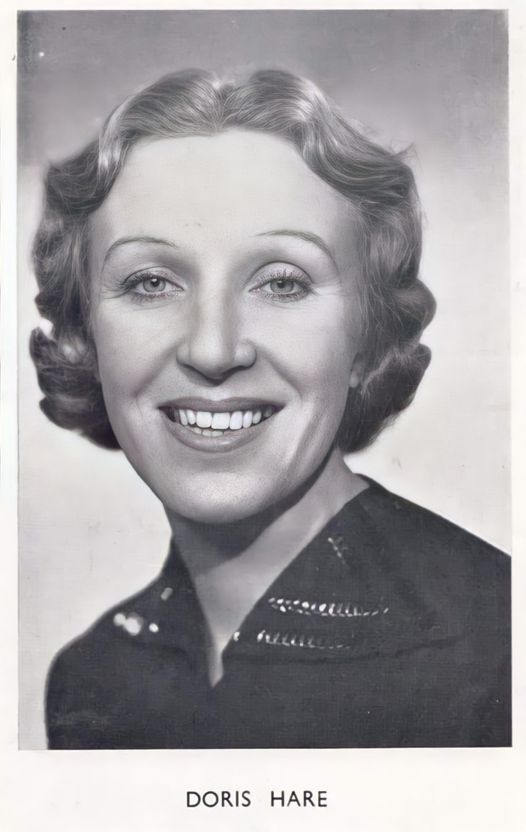


Remembering Welsh entertainer Doris Hare MBE, born March 1st, 1905.
She was born into a travelling theatrical family and made her stage debut in a speaking role aged three, then worked for decades in music hall, variety and musical theatre, and in the 1960s for the Royal Shakespeare Company and National Theatre.
During World War Two she hosted a radio programme especially for merchant mariners, Shipmates Ashore, and became 'the Sweetheart of the Merchant Navy', for which she was awarded the MBE.
She found later fame as 'Mum' in On the Buses, on television and in the cinema adaptations (1969-73), and in three 'Confessions' sex comedies, which were some of the most profitable British films of the 1970s.

Her film career spanned 60 years, from Night Mail in 1935 to her final credit, Second Best, directed by Chris Menges and starring William Hurt and Keith Allen, in 1994.
According to a tribute in the Borehamwood and Elstree Times:
"...At the grand age of 87, Doris Hare was to take to the West End stage one last time. Doris appeared at the Playhouse Theatre in the Ray Cooney farce, It Runs in the Family. The role saw her reunited opposite former Benny Hill straight man, Henry McGee..."
She passed away at Denville Hall, the residential care home for artistes, on May 30th, 2000.
#social history#british culture#british theatre#british television#music hall#musical theatre#variety#british comedy#on the buses#confessions#british cinema#doris hare#welsh actors
5 notes
·
View notes
Text
All it takes is watching one (1) musical in-person to understand the world would be a tremendously boring place if everyone looked like a super model.
#the actors in all their different shapes and sizes and silhouettes#the variety of appearance#like I dunno the best characters are the ones who look and feel like real people#theatre perspective W#LE snake diaries
1 note
·
View note
Text
Does anyone else daydream about becoming some kind of crazy billionaire celebrity á la Claire Zachanassian specifically so you can return to your home country and make everyone see musicals as a valid art form just through Sheer Force Of Cash or are y'all normal
#unhinged post inspired by:#me looking into a recent local commercial musical production venture (gone wrong) through social media posts and news articles#and everyone in the comments is like 'nobody in finland cares about musicals they're useless drivel anyway'#oabföskgl#if only i had about 2.5 billion euros...#good things can come out of the city theatre system (and technically it keeps prices affordable.......ish...) but i just want Variety#if i had a lot of money i could produce musicals commercially without them being commercial nightmares oahdkdökg#a lot of the lot of money would go into bribing the vbw so they'd let me get rid of kkog#ramble#musicals#theatre
11 notes
·
View notes
Text
Guess who just saw Kit in his magic show!!


#spoiler its me#im so happy i love seeing all varieties of theatre and this was really unique#no spoilers tho go see it quick before it closes#kit young#shadow and bone#quality photo that second one
6 notes
·
View notes